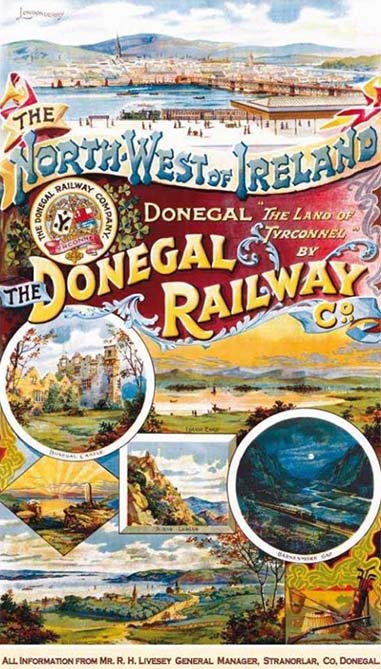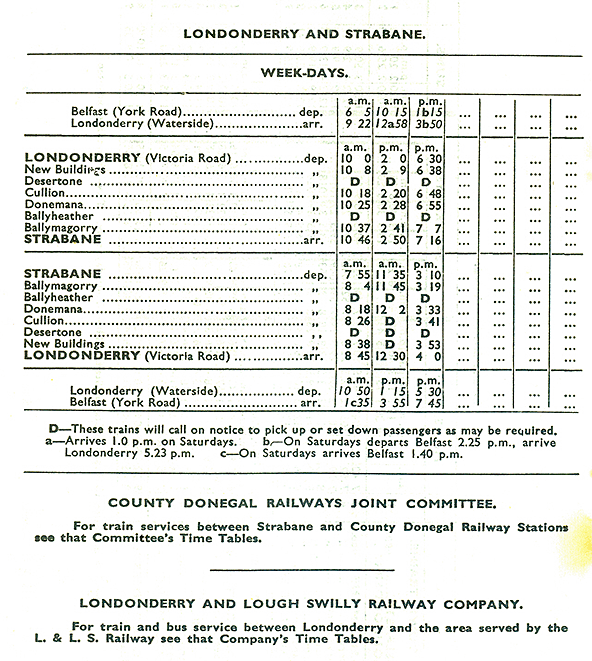 Desertone Halt looking south on 14 May 1955. The halt had not seen a train since 31 December 1954 when the last scheduled services had run. Desertone Halt looking south on 14 May 1955. The halt had not seen a train since 31 December 1954 when the last scheduled services had run.
Copyright photo by Michael Bunch from the Donegal Railway Heritage Centre collection.
On 7 August 1896 the Donegal Railway (DR) obtained an act to build a 14½ mile single track 3ft gauge railway between Strabane and the Waterside area that lay on the eastern bank of the Foyle opposite the walled city of Derry/Londonderry. In 1896 the DR had a 74 mile network of railways of the 3ft gauge that had Strabane as their easternmost point. To get goods and passengers to and from the important city of Derry/Londonderry required the use of the Great Northern Railway Ireland (GNRI) 5ft 3inch gauge line between Strabane and Londonderry Foyle Road. Financially this situation was to the detriment of the DR and to the advantage of the GNRI, which was the primary reason for the line.
 The line opened for goods services on 1 August 1900 and passenger services began six days later. A station was at provided at the Waterside area which was called Londonderry Victoria Road. Passengers could move into the city via the double deck Carlisle Bridge which was adjacent to the station. Goods traffic was exchanged with the LMS station using the lower deck of what became the Craigavon Bridge, with the GNR and L&LSR stations using the mixed gauge LP&HC lines. At the time of opening there were four intermediate stations on the line with another halt (at Ballyheather) being added by the DR in 1908. The line opened for goods services on 1 August 1900 and passenger services began six days later. A station was at provided at the Waterside area which was called Londonderry Victoria Road. Passengers could move into the city via the double deck Carlisle Bridge which was adjacent to the station. Goods traffic was exchanged with the LMS station using the lower deck of what became the Craigavon Bridge, with the GNR and L&LSR stations using the mixed gauge LP&HC lines. At the time of opening there were four intermediate stations on the line with another halt (at Ballyheather) being added by the DR in 1908.
Victoria Road was not the only station at the Waterside area. Londonderry Waterside station had opened in 1852, and since 15 May 1860 it had been the terminus of the Belfast & Northern Counties Railway (BNCR). In 1903 the BNCR had been taken over by the Midland Railway (MR), an English company that had aspirations for expansion in Ireland. They looked west from Derry/Londonderry and saw an opportunity in the form of the DR. They entered into discussions with them with regards to a takeover. The GNRI saw this as a threat and made it clear that they would try to block such a move. A compromise was reached which involved the MR and the GNRI taking control of the DR as equal partners. On 1 May 1906 the DR was absorbed by the two larger companies who ran it through a board as the County Donegal Railway Joint Committee (CDR). As the GNRI had a route between Strabane and Derry/Londonderry the line between Londonderry Victoria Road and Strabane passed solely to the MR.
The line ran to the east of the River Foyle through Counties of Tyrone and Londonderry and it passed close to the small settlements of Drumagore, Killymallaght and Disertowen. The MR wanted to increase passenger traffic on the line so in 1908 they opened Desertone Halt. The halt was located in a cutting just to the north of an overbridge which carried Trench Road across the line. On the east side of the bridge a sloping footpath connected Trench Road to a timber built platform. Located at the bottom of the footpath at the entrance to the platform was a small timber hut, with a pitched roof, which would have been used to sell tickets to passengers. On the platform there was another simple wooden structure with a curved roof that most probably served as shelter.
At the time of opening the halt was served by 6 up (Londonderry Victoria Road direction) and 5 down (Strabane direction) trains. In 1912 a Sunday service of one train in each direction was introduced and 1913 an additional Sunday out and return working was added.
On 4 August 1914 the British Empire declared war on Germany and entered the Great War. From 1 January 1917 the CDR was taken under government control (along with all of the other Irish railways). The Sunday services were withdrawn in 1917 and never reinstated. The weekday service was also reduced to four trains in each direction.
In 1919 the Irish War of Independence broke out and it caused much disruption to the CDRJC system. In December 1921 a treaty was negotiated which resulted in the island of Ireland being split into two separate countries, the Irish Free State and Northern Ireland which remained as part of the United Kingdom. The majority of the CDRJC lines were located within the Irish Free State but the route through Desertone lay within Northern Ireland. This caused difficulties for the company, which were exacerbated by the outbreak of the Irish Civil War (1922-23) which caused even more disruption. The least disrupted route was the Londonderry Victoria Road – Strabane line on which no major incidents were recorded as it ran through a mainly Unionist area.
The July 1922 timetable showed Desertone as being a request stop with only 2 up and 3 down trains Monday-to-Saturday.
During the Second World War (1939-45) the CDRJC saw an upturn in traffic. There was a high volume of cattle movements from the Irish Free State to Londonderry. Because the GNRI main line between Londonderry Foyle Road and Strabane passed through the Irish Free State it could not be used for the movement of war materials or troops (the Free State being a neutral country). As the Londonderry Victoria Road and Strabane line was located entirely within Northern Ireland serious consideration was given in 1942 to making it dual gauge (3ft and 5ft 3in), so that GNRI trains could reach Londonderry without having to pass through the Irish Free State. In the end the idea proved to be too complicated and all war related traffic had to operate via the LMS NCC main line to Derry/Londonderry, a vital wartime naval port, instead.
The 1946 LMS timetable (see below) showed that Desertone was still a request stop but 3 trains in each direction were able to serve it.

In January 1948, when the LMS was nationalised as part of the Railway Executive the NCC share of the CDR passed to the London Midland Region of British Railways. By April 1949 the railways of Northern Ireland, with exception of the CDR, GNRI and the SL&NC (as they operated in two countries), were also nationalised as part of the Ulster Transport Authority (UTA). In April 1949 the former NCC network was purchased by the Northern Ireland government on behalf of the UTA for £2.67 million. Being part of the NCC network the Strabane – Londonderry Victoria Road line passed to the UTA but it continued to be worked by the CDR. The UTA paid the costs of the Londonderry Victoria Road service and that meant that there was no incentive to economise. For this reason the trains on this section of the CDR network were always steam operated and the CDR designed their timetable after the 1930s so that all steam locos in service would visit Victoria Road.
The UTA announced its intention to close the line between Londonderry Victoria Road and Strabane in October 1954. The last trains ran on 31 December 1954.
On 29 June 1955 a light engine made a journey through Desertone as part of a round trip between Strabane and Londonderry Victoria Road. The purpose of this movement was to test the permanent way for a special excursion train that was to run on 30 June 1955. The excursion train, carrying Sunday School children as part of an outing to Portrush (via a short walk between Victoria Road and Waterside stations), operated as scheduled. The down train that passed through Desertone on the return leg of the journey would be the very last train to pass through the station.
Track lifting began at Londonderry Victoria Road in November 1955. Desertone had been reached by mid-December 1955 and all rails had been removed from the halt area by the end of that year.
Today there are few obvious signs of where Desertone Halt was located. Trench Road has been straightened and cuts across the cutting which has been filled at that point. However the original bridge over the line survives just to the south of the infill and new alignment. From the realigned road the cutting in which Desertone Halt was located can be seen but it is heavily overgrown. Full size copies of the Donegal Railway Company poster (shown above) can be purchased from the Donegal Railway Heritage Centre |

 Home
Page
Home
Page

 Home
Page
Home
Page